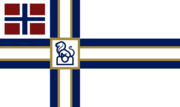Auroa: Difference between revisions
No edit summary |
No edit summary |
||
| Line 12: | Line 12: | ||
|capital = New Alexandria | |capital = New Alexandria | ||
|largest_city = New Alexandria | |largest_city = New Alexandria | ||
|official_languages = Arani <br> Nordic | |official_languages = Arani <br> Gothic <br> Nordic | ||
|regional_languages = Venetian | |regional_languages = Venetian | ||
|ethnic_groups = | |ethnic_groups = | ||
|ethnic_groups_year = | |ethnic_groups_year = | ||
Revision as of 03:14, 15 November 2023
Republic of Aranea אַינאַרע קילבופּר Republikh Erania | |
|---|---|
| Motto: טסעפֿ טואַיאָל ןי In Loyalty Steadfast | |
| Capital and largest city | New Alexandria |
| Official languages | Arani Gothic Nordic |
| Recognised regional languages | Venetian |
| Demonym(s) | Arani Aranean |
| Government | Federal parliamentary constitutional monarchy |
| Area | |
• Total | 488,530 km2 (188,620 sq mi) |
| Population | |
• 2022 census | 40,134,503 |
| Currency | Mark (ƒ) (AUM) |
| Date format | dd-mm-yyyy CE |
| Driving side | right |
| Calling code | +63 |
| ISO 3166 code | ARN |
| Internet TLD | .arn |
Aranea, officially the Republic of Aranea, is a country located in Siduri in Tyran. It is bordered to the west by Knichus and to the south by Lemobrogia.
Auroa remained an Acrean territory until the 20th century. It was granted co-equal status with Acrea in the Riksdag in 1952, and later ratified and adopted its own constitution in 1990, making Auroa fully independent.
Today, Auroa is a developed country with high income. Technology and services form the majority of its economy, though natural resources and agricultural goods are critically important economic sectors, whose competing interests have been a longstanding focal point of political debate within the country. Auroa maintains a professional standing army, resulting from its highly militarised status under Acrean rule as well as the cultural disposition of both its native and colonial-descent populations. In its politics and economics, remains closely aligned with Acrea. Despite this, Auroa has maintained a policy of non-intervention in regions outside its immediate own, and had not participated in a foreign conflict since the end of Acrean rule until the 2021 Continuation War.
History
Auroa has traditionally been divided into territory controlled by various clans, which were divided amongst both tribal and ethnic lines. Two ethnic groups are included under the label of native Auroans: the Aōtea. Both the Aōtea largely resisted foreign influence into their lands, desiring to preserve their traditional culture and often had strict controls on trade, though some tribes were more open than others.
Auroa's relative isolation ended in 1461 with the arrival of Alexander Vennerod, an Acrean naval officer leading a flotilla of four Acrean warships. Vennerod landed at the major Aōtean coastal city of Koori. In negotiations with the Ngāti Maru, a mixed Aōtean clan which ruled that region, Vennerod delivered the request that they open their land to foreign trade and relations. In addition to being a symbolic message, Vennerod's warships also carried a large volume of goods intended as demonstrations and gifts including firearms and gunpowder. After a month of talks, the Ngāti Maru agreed to negotiate opening their territory, with Vennerod acting as a mediator between the Ngāti Maru and the Acrean crown. In 1463, the Ngāti Maru agreed open their capital city to Acrean trade and signed the Treaty of Narara. In addition to new trade, the Treaty also allowed the establishment of a diplomatic mission in Koori. Vennerod commandeered a former local clan administrator's office to house it after he returned to the country in 1464. Although other clans gradually opened their lands as well, the Maru rapidly expanded their power due to their new wealth and wide adoption of new technolgies, such as firearms. Acrean influence in the Maru also expanded exponentially, which created conflicts between the Maru and their allied clans, and a large bloc of clans primarily from the south and east of Auroa who disliked the foreign presence in northern Auroa. Grievances and disagreements grew gradually over the course of several decades, during which Acrea's presence in Auroa grew exponentially. Permanent merchants had established themselves in Koori by 1470, and an Acrean diaspora had congregated in the city from the families of diplomats, merchants, and prospective businesspeople in an enclave named New Alexandria, in dual honour of Vennerod and the ancient Acrean city.
Tensions between the Maru and other clans broke out into a conflict in 1493. The southern Aōtean clans united into a confederation called the Arawa to confront the Maru. Heavily outnumbered and outgunned, the Maru called on Acrea for assistance, who joined the war on the side of the Maru bringing with them substantial numbers and armaments than the Arawa could muster. The Arawa initially engaged the Acreans and the Maru in pitched battles, utilising traditional Aōtean tactics. They suffered several major defeats at the hand of the Acreans and the Maru. As a result, rather than face the Acreans and Maru in open battle, the Arawa engaged them in a protracted guerilla conflict, sacrificing much territory in the process but drawing out the conflict for over two decades.
Geography
Although fairly small in size, Auroa has a diverse geography and climate with incredibly rich biodiversity. The northern Auroan climate is subtropical, with lush jungle covering terrain that is significantly varied in elevation. The southwestern border is effectively fenced off by mountains as one approaches Lemobrogia. The jungles open to an oceanic climate along the coasts and in central Auroa and are the country's predominant agricultural regions.

